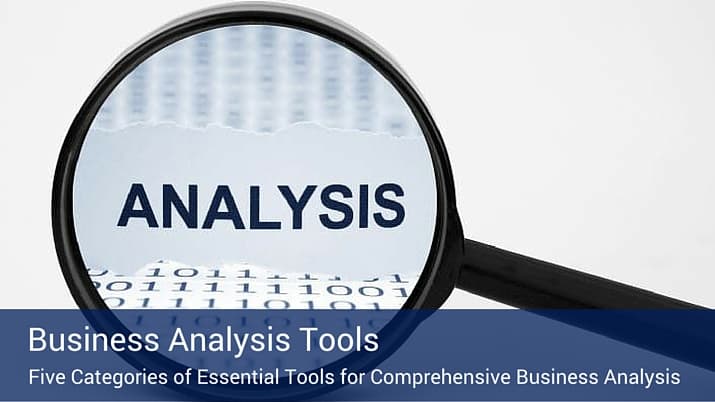Understanding Key Business Analysis Tools

Last Updated August 12, 2014
For business analysts, a wide scope of tools can be employed for researching the needs of an organization or business sector and identifying the solutions required to bring it back to health while facilitating the change. One common challenge is not just having the tools readily available, but having the know-how and skills to use the right tools for the right purpose.
Categories of business analysis
The tools available for business analysts typically fall into five categories:
- Strategy analysis based on evaluation of the external business environment
- Strategy analysis based on evaluation of internal capabilities
- Strategy definition to help define the business strategy best suited to address the need
- Strategy implementation
- Performance measurement
Strategy analysis – external business environment
- PESTLE (Political, Economic, Social, Technical, Legal and Environmental) Analysis – This analysis can be helpful when gauging the broader business environment and the opportunities and threats within it, making it easier to manage the market risks and their impact on an organization’s growth strategy. Often used as part of a SWOT analysis (see below), it can be used to explore a strategy, a marketing initiative or a business idea while evaluating the direction a business is taking.
- Porter’s Five Forces Model – This model gauges a business’ position relative to five distinct forces characterizing the industry’s competition. The strength of the competition influences the extent of a company’s potential profitability. The forces include the intensity of rivalry, how much of a threat is posed by new market entrants, the amount of bargaining power held by suppliers as well as customers, and the level of threat posed by substitute products
Strategy analysis – internal capability
- MOST Analysis – By understanding and refining their Mission, Objectives, Strategies and Tactics, businesses can adjust their direction to improve their industry position and performance. This analysis helps identify business distractions and how their removal can drive advances in the market and with customers and suppliers. Ultimately, it can lead to a stronger link between the business and the mission statement.
- Resource Audit – For businesses to effectively respond to internal and external circumstances, proper resources and proficiencies should be in place and ready to implement. These are identified through a resource audit that focuses on items that are owned or can be obtained. They are usually grouped in the following categories: financial (cash, loans, ability to raise new funds, etc.), human resources (the skills base of the business), physical resources (from production facilities to IT systems) and those that are intangible (goodwill, reputation, brands and intellectual property).
- Portfolio Analysis (Boston Box) – Portfolio proliferation is a growing business problem which typically wastes marketing resources, destroys economy of scale and creates marketplace confusion. The Boston Box for portfolio rationalization analyzes products according to their market share and growth in four categories: stars, or high growth/high investment products, cash cows, or low growth/low investment products, question marks, those with low share in high growth markets that may have potential, and dogs, sold or closed.
Strategy definition
- SWOT Analysis – This exercise maps an organization’s strengths and weaknesses (or internal environment) against the opportunities and threats posed externally, and typically is conducted for a business unit or idea versus a market, per the PESTLE analysis. Typically undertaken as part of a workshop or brainstorming effort, SWOT analysis looks at factors in the present, such as products, pricing, profitability and performance, and weighs them against factors that could have impact in the future, such as culture, technology, audience and market shifts.
- Ansoff’s Matrix – This tool for business analysis helps an organization understand market or business development opportunities by looking at four options for strategy development. Market penetration is an option in situations where growing market share is possible or when the market can accommodate the kind of growth the business seeks. Another focuses on new products developed internally, via acquisitions or through joint ventures, as a route to increased share. A third is market development, looking at entirely new markets or new sub-sets to existing ones as a strategy for growth. The fourth is diversification, or a strategy where new products are taken to new markets, which is likely to require new distribution channels.
Strategy implementation
- The McKinsey 7-S model – With the opinion that all parts work in harmany at successful companies, this model helps businesses understand how well they are aligned by exploring seven interdependent factors. These include more easily defined and influenced hard elements of strategy, structure and systems, such as strategy statements, organization charts and IT systems. They also explore four soft elements that are less tangible, but are equally important as the hard ones in driving success. These elements include shared values, skills, style and staff.
Performance measurement
- The Balanced Business Scorecard – The idea behind the scorecard is to ensure the alignment of a business’ performance, vision and objectives. This means that not only is its financial performance evaluated, but so are customer concerns, business processes and learning tools and mechanisms. Those perspectives are weighed against four factors in assessing an organization’s performance: Objectives, measures, targets and initiatives. Among other benefits, the balanced scorecard helps sharpen a business’ focus on business strategy, while effectively aligning employees around the strategy. It also helps leaders better target actions that impact future performance.
A wealth of tools are available to support the kind of business analysis that enables an organization to chart a future course that aligns with its overarching mission, objectives and strategy. The better the grasp that business analysts have on these tools and where and when they have value, the better able they may be to understand and evaluate issues and ideas for effective action.





